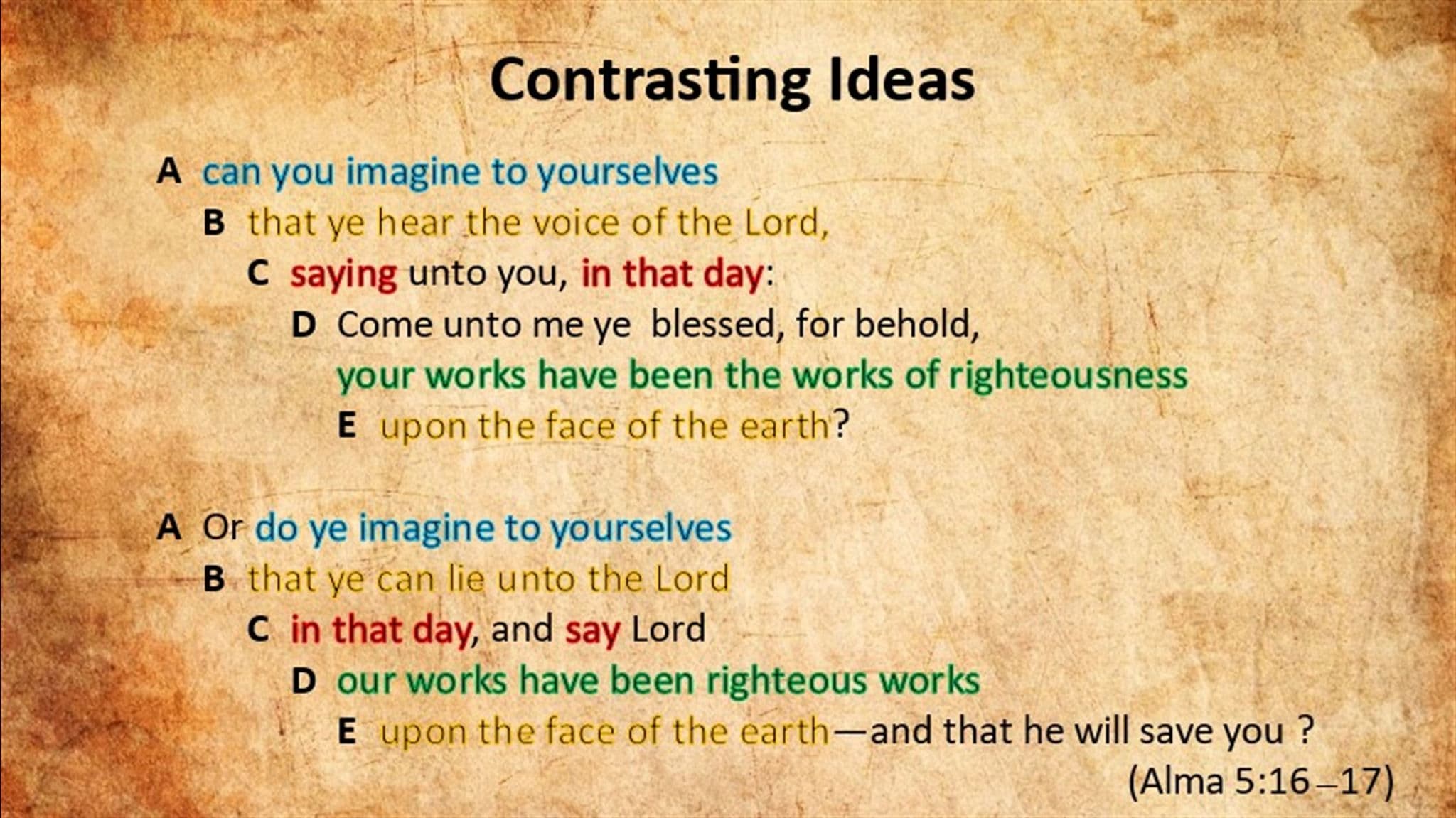Evidence #289 | December 21, 2021
Book of Mormon Evidence: Contrasting Ideas
Post contributed by
Scripture Central

Abstract
The Book of Mormon features dozens of examples of a parallelism known as “contrasting ideas,” providing evidence of the text’s Hebrew origins and literary complexity.One type of parallelism featured in the Book of Mormon is known as contrasting ideas. Hebrew scholar Donald Parry describes it as “a literary structure that throws or compares one subject or idea against another, for the purpose of creating a contrast between the two ideas.”1 This form is very similar to antithetical parallelisms,2 the only real difference being in the degree to which parallel ideas express opposition.3 Here is an example of contrasting ideas from 1 Nephi 4:3:
A | the Lord is able to deliver us, | |
| B | even as our fathers, |
A | and to destroy Laban, | |
| B | even as the Egyptians. |
In this instance, the Lord providing deliverance is contrasted with him doling out destruction, Nephi and his brothers are contrasted with Laban, and the Israelites are contrasted with the Egyptians—all set in a parallel structure that collectively contrasts one set of ideas with the other. Here are several more examples:
A | as many of the Gentiles | ||
| B | as will repent | |
|
| C | are the covenant people of the Lord; |
A | and as many of the Jews | ||
| B | as will not repent | |
|
| C | shall be cast off |
A | can you imagine to yourselves | ||||
| B | that ye hear the voice of the Lord, | |||
|
| C | saying unto you, in that day: | ||
|
|
| D | Come unto me ye blessed, for behold, your works have been the works of righteousness | |
|
|
|
| E | upon the face of the earth? |
A | Or do ye imagine to yourselves | ||||
| B | that ye can lie unto the Lord | |||
|
| C | in that day, and say Lord | ||
|
|
| D | our works have been righteous works | |
|
|
|
| E | upon the face of the earth—and that he will save you? |
A | if they have been righteous | ||
| B | they shall reap the salvation of their souls, | |
|
| C | according to the power and deliverance of Jesus Christ; |
A | and if they have been evil | ||
| B | they shall reap the damnation of their souls, | |
|
| C | according to the power and captivation of the devil. |
Conclusion
Dozens of examples of contrasting ideas can be found throughout the Book of Mormon (see Appendix). Most of these instances are simple couplets, but over a dozen contain 3 or more layers. This literary form dovetails nicely with the Book of Mormon’s many other Hebrew literary features,4 while also manifesting another aspect of the book’s literary complexity and sophistication.
Carl J. Cranney, “The Deliberate Use of Hebrew Parallelisms in the Book of Mormon,” Journal of Book of Mormon Studies 23, no. 1 (2014): 140–165.
Donald W. Parry, Poetic Parallelisms in the Book of Mormon: The Complete Text Reformatted (Provo, UT: Neal A. Maxwell Institute for Religious Scholarship, 2007).
Donald W. Parry, “Hebraisms and Other Ancient Peculiarities in the Book of Mormon,” in Echoes and Evidences of the Book of Mormon (Provo, UT: FARMS, 2002), 155–189.
Hugh J. Pinnock, Finding Biblical Hebrew and Other Ancient Literary Forms in the Book of Mormon (Provo, UT: FARMS, 1999).
Contrasting Ideas
1 Nephi 4:3
1 Nephi 22:19
2 Nephi 1:10
2 Nephi 2:27
2 Nephi 2:29
2 Nephi 4:4
2 Nephi 9:23–24
2 Nephi 9:39
2 Nephi 26:25
2 Nephi 28:28
2 Nephi 30:2
2 Nephi 31:5
2 Nephi 32:8
Jacob 6:3
Omni 1:25
Mosiah 13:27
Mosiah 16:11
Mosiah 26:35–36
Mosiah 29:26
Alma 5:16–17
Alma 5:40
Alma 5:41
Alma 6:2–3
Alma 9:13
Alma 28
Alma 12:10
Alma 19:31–32
Alma 22:6
Alma 28:11–12
Alma 36:30
Alma 37:13
Alma 38:1
Alma 41:4
Alma 50:20
Helaman 12:26
Helaman 14:18
Helaman 14:29
Helaman 14:31
3 Nephi 6:9–10
3 Nephi 6:12
3 Nephi 11:33–34
3 Nephi 13:14–15
3 Nephi 14:13–14
3 Nephi 14:24–27
3 Nephi 26:5
3 Nephi 26:9–10
3 Nephi 27:33
Mormon 8:37
Ether 4:18
Moroni 7:16–17
- 1. Donald W. Parry, Poetic Parallelisms in the Book of Mormon: The Complete Text Reformatted (Provo, UT: Neal A. Maxwell Institute for Religious Scholarship, 2007), xxxiv.
- 2. Evidence Central, “Book of Mormon Evidence: Antithetical Parallelisms,” Evidence# 0282, December 13, 2021, online at evidencecentral.org.
- 3. In many cases, whether a parallelism should be considered antithetical or merely a contrast of ideas is debatable, involving a subjective evaluation of the degree of opposition involved.
- 4. Curiously, unlike his description of most other parallelisms, Parry doesn’t provide any examples of contrasting ideas from the Bible. The reason for this is never explained. The literary form’s near—almost identical—resemblance to antithetical parallelism, however, suggests it is similarly of Hebrew origin. See Parry, Poetic Parallelisms in the Book of Mormon, xxxi–xxxiii.